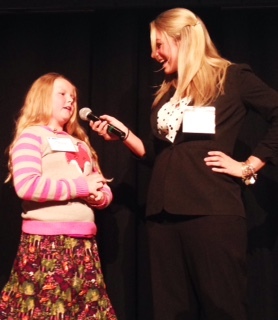Stand up and speak out.
That was the key message delivered to 100 students from all corners of Idaho during a two-day education conference conducted by Boise State University’s Idaho Leads Project.

Nearly 400 educators plus 100 students from 100 schools met at the Boise Centre Monday and Tuesday to discover ways to improve teaching and learning.
Each school was required to bring a student and those students received one message loud and clear — their voice matters.
“I learned that student voices can give teachers different perspectives,” said Bridge McAffee, a middle school student from Idaho Falls. “Teachers should be more open to kids sharing their opinions.”
Students, teachers and administrators worked in small groups during much of the conference and students were encouraged to do most of the talking.
Orofino School District Superintendent Robert Vian said he is not doing nearly enough to make sure students are heard.
“We’re going to go back and do a student survey because we need to make sure they feel like they belong,” Vian said. “If we don’t have kids feeling like they belong and it’s their school, they are never going to care about curriculum.”
The conference included 20 districts from Lake Pend Oreille and Garden Valley to Twin Falls and Idaho Falls.
On Monday, the conference featured author and speaker Russell Quaglia, who shared the importance of authentically involving student voice and aspirations in schools. Aspirations, Quaglia said, are about encouraging students to dream and set goals for the future while being inspired in the present to reach those dreams.
“If you know them and connect with them, you can better serve their needs,” Quaglia said. “Let’s remember, the goal of school is life – not more school.”
On Tuesday, students participated in youth leadership training, while adults worked with author and renowned education leader Michael Fullan to develop instructional strategies that better engage students and teachers.
“This is the first year my voice has been heard in school,” said Orofino High School senior Sami Vaughn. “It’s important that I also listen to everyone.”
Buhl High School junior Allison Hauser said: “I learned that we can make decisions if we are allowed. We have the ability. Decisions can be released to us by letting us do things, by giving us a choice.”
Quaglia, founder of Quaglia Institute for Student Aspirations, said there is a disconnect between what students say and what’s being practiced in schools. For example, only 34 percent of students believe teachers know their hopes and dreams. Less than half of students say they have a voice in school decisions.
“We need to believe that students have something to teach us, that students are the potential and not the problem,” Quaglia said. “Showing you truly care about them is more important than curriculum.”
He said students are eight times more likely to succeed if they think teachers care about them. Students are 16 times more likely to succeed if they are engaged in classrooms and in school activities.
“What we teach, how we teach and why we teach are equally as important as who we teach,” added Kathleen Budge, a co-director of the Idaho Leads Project.
Fullan was the featured speaker on the second day of the conference talking about systemic and sustainable change and making sure schools are equipping students for tomorrow’s world. He said this kind of work is unique to his home province of Ontario, Canada, and Idaho.
“Mobilizing students and teachers, this is the beginning of the journey,” Fullan said.
The Idaho Leads Project is a Boise State University professional development team in its third year, funded by the J.A. and Kathryn Albertson Foundation.
The 20 districts selected to participate in this event came from Idaho Leads’ 75 member districts, which have more than 400 schools. More regional conferences are scheduled throughout the winter.
“The purpose of engaging with the smaller group is to go deeper into our work surrounding building leadership capacity and the implementation of the Idaho Core,” said Idaho Leads co-director Lisa Kinnaman. “This is an amazing opportunity for Idaho educators to have direct access to these world-renowned education experts, and to work together on some truly innovative ways to improve education in Idaho.”
Disclosure: Idaho Education News is housed under the Idaho Leads Project; both projects are funded by the J.A. and Kathryn Albertson Foundation.
